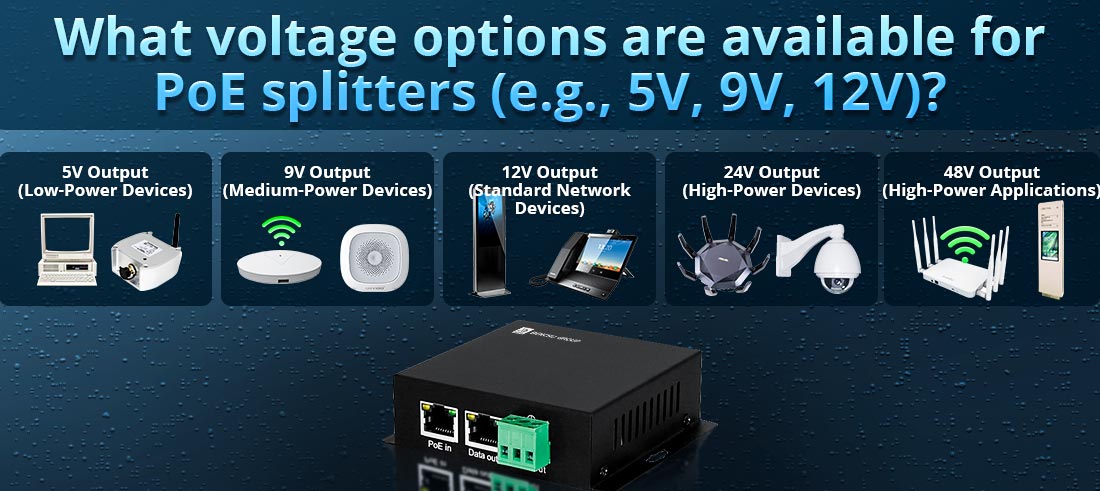
Os divisores de POE extraem a potência de uma fonte de energia sobre Ethernet (POE) (normalmente 48V-57V DC) e a convertem em uma tensão mais baixa adequada para dispositivos não-POE. As opções de tensão disponíveis dependem do padrão POE que está sendo usado e dos requisitos de energia do dispositivo conectado.
1. Opções comuns de tensão do divisor de POE
| Saída de tensão | Casos de uso típicos | Padrões POE apoiados |
| 5V DC | Raspberry Pi, dispositivos IoT, gadgets movidos a USB | 802.3AF (15,4W) / 802.3AT (30W) |
| 9V DC | Controladores industriais, determinados dispositivos de rede | 802.3AF (15,4W) / 802.3AT (30W) |
| 12V DC | Câmeras IP, telefones VoIP, conversores de mídia, pontos de acesso | 802.3AF (15,4W) / 802.3AT (30W) |
| 24V DC | Pontes sem fio, câmeras PTZ, equipamentos industriais | 802.3AT (30W) / 802.3BT (60W) |
| 48V DC | Wi-Fi 6 APS de alta potência, sinalização digital, iluminação inteligente | 802.3bt (60W - 100W) |
2. Avaria detalhada das opções de tensão
(a) Saída de 5V (dispositivos de baixa potência)
Comum para pequenos eletrônicos e sistemas incorporados.
Aplicações típicas:
--- Raspberry Pi e outros computadores de placa única.
--- Sensores de IoT e dispositivos domésticos inteligentes.
--- dispositivos movidos a USB.
--- Geralmente suporta até 2A saída (10W máx).
(b) Saída 9V (dispositivos de potência média)
Menos comum, mas usado para controladores industriais e dispositivos de rede especializados.
Aplicações típicas:
--- Alguns pontos de acesso mais antigos.
--- Controladores de rede incorporados.
--- Eletrônica industrial personalizada.
--- suporta até 2A saída (18W máx).
(c) Saída de 12V (dispositivos de rede padrão)
A tensão mais amplamente usada para Poe Splitters.
Aplicações típicas:
--- câmeras IP (fixo, cúpula, tipos de bala).
--- telefones VoIP.
--- Conversores de mídia de rede.
--- Pequenos pontos de acesso sem fio.
--- Geralmente, fornece até 2.5A de saída (30W máx).
(d) Saída de 24V (dispositivos de alta potência)
Usado para redes especializadas e equipamentos industriais.
Aplicações típicas:
--- Pontes sem fio e APs ao ar livre.
--- PTZ (Pan-Tilt-Zoom) Câmeras com motores.
--- Sensores industriais e sistemas de automação.
--- pode fornecer até 2,5a (até 60W máximo).
(e) Saída de 48V (Aplicações Enterprise e Industrial)
Requer IEEE 802.3bt (Poe ++) apoiar.
Aplicações típicas:
--- Pontos de acesso Wi-Fi 6 de alto desempenho.
--- Displays de sinalização digital.
--- Iluminação inteligente e automação de edifícios.
--- Clientes magros e mini PCs.
--- pode fornecer até 100W de energia.
3. Como escolher a tensão certa para o seu divisor POE
--- Verifique os requisitos de entrada de energia do dispositivo (por exemplo, 12V 1A, 24V 2A).
--- Combine a tensão com o seu dispositivo-usar a tensão errada pode danificar o dispositivo.
--- Verifique se sua fonte POE (comutador ou injetor) suporta potência suficiente.
--- Escolha o conector de saída correto-a maioria dos divisores de POE usa 5,5 mm x 2,1 mm ou 5,5 mm x 2,5 mm DC, conectores.
Conclusão
Os divisores de POE fornecem diferentes saídas de tensão (5V, 9V, 12V, 24V e 48V) para acomodar vários dispositivos de rede, IoT e industrial. A escolha da tensão certa garante compatibilidade, entrega eficiente de energia e operação segura do seu equipamento.